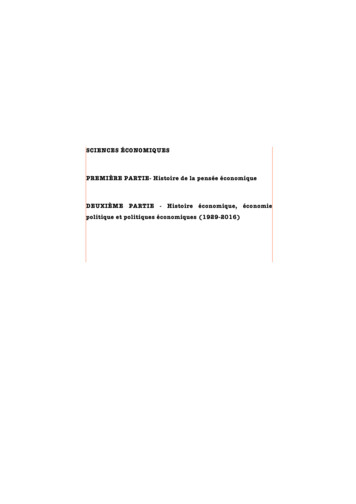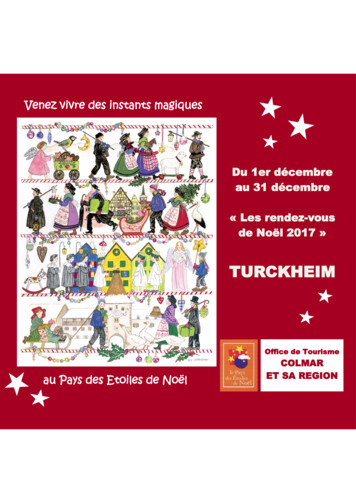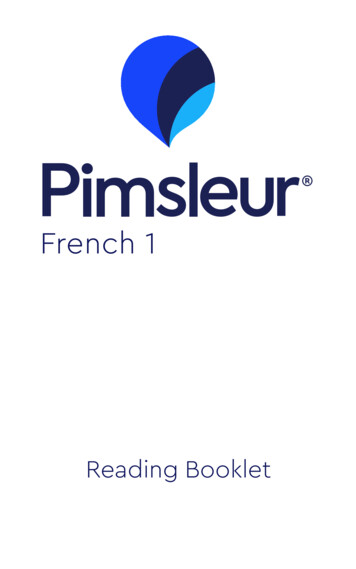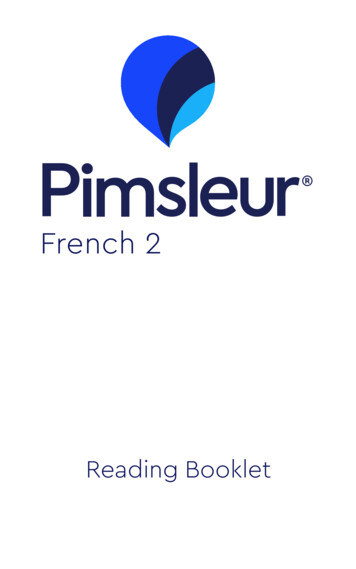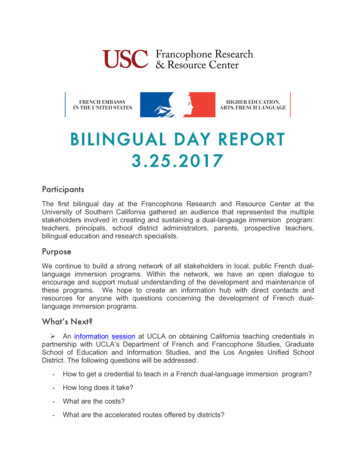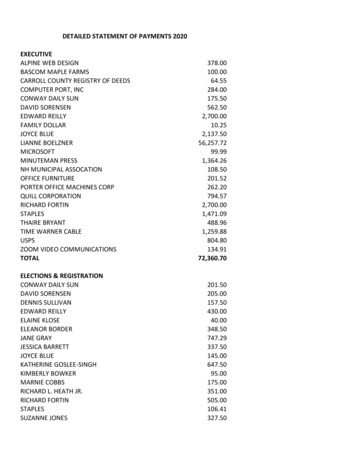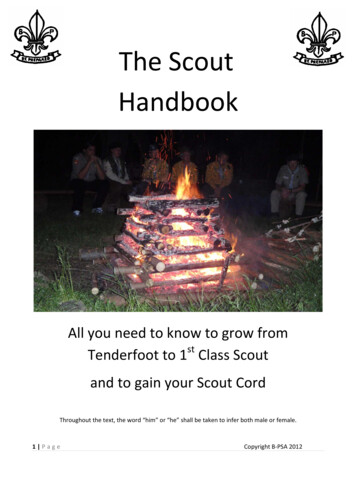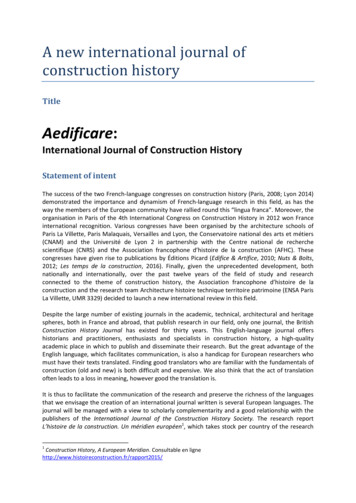
Transcription
A new international journal ofconstruction historyTitleAedificare:International Journal of Construction HistoryStatement of intentThe success of the two French-language congresses on construction history (Paris, 2008; Lyon 2014)demonstrated the importance and dynamism of French-language research in this field, as has theway the members of the European community have rallied round this “lingua franca”. Moreover, theorganisation in Paris of the 4th International Congress on Construction History in 2012 won Franceinternational recognition. Various congresses have been organised by the architecture schools ofParis La Villette, Paris Malaquais, Versailles and Lyon, the Conservatoire national des arts et métiers(CNAM) and the Université de Lyon 2 in partnership with the Centre national de recherchescientifique (CNRS) and the Association francophone d’histoire de la construction (AFHC). Thesecongresses have given rise to publications by Éditions Picard (Edifice & Artifice, 2010; Nuts & Bolts,2012; Les temps de la construction, 2016). Finally, given the unprecedented development, bothnationally and internationally, over the past twelve years of the field of study and researchconnected to the theme of construction history, the Association francophone d’histoire de laconstruction and the research team Architecture histoire technique territoire patrimoine (ENSA ParisLa Villette, UMR 3329) decided to launch a new international review in this field.Despite the large number of existing journals in the academic, technical, architectural and heritagespheres, both in France and abroad, that publish research in our field, only one journal, the BritishConstruction History Journal has existed for thirty years. This English-language journal offershistorians and practitioners, enthusiasts and specialists in construction history, a high-qualityacademic place in which to publish and disseminate their research. But the great advantage of theEnglish language, which facilitates communication, is also a handicap for European researchers whomust have their texts translated. Finding good translators who are familiar with the fundamentals ofconstruction (old and new) is both difficult and expensive. We also think that the act of translationoften leads to a loss in meaning, however good the translation is.It is thus to facilitate the communication of the research and preserve the richness of the languagesthat we envisage the creation of an international journal written is several European languages. Thejournal will be managed with a view to scholarly complementarity and a good relationship with thepublishers of the International Journal of the Construction History Society. The research reportL’histoire de la construction. Un méridien européen1, which takes stock per country of the research1Construction History, A European Meridian. Consultable en 5/
2and teaching in the field for the years 2004–14, is undeniable proof of the growth in the field ofconstruction history and consequently of the fact that a new publication in Europe is required.Objectives of the journalThe journal has four main objectives:- To make the public and construction professionals aware of the materiality of architecture (the roleof the materials, construction processes, the construction site, the players in construction, etc.) andof its technical heritage.- To create a work space that brings together researchers from different disciplines (history or art andarchitecture, history of techniques, archaeology, anthropologies, history of law and economics, etc.)and practitioners (architects, engineers, restorers, curators).- To bring together researchers and professionals from large, medium-size and small building firms byreporting on the research carried out by these firms.- To provide a platform for PhD students to publish articles about their current theses and theirconclusions or outcomes.Call for contributionsConstruction history is not a discipline, but a subject of scholarly research that is increasing indemand both nationally and internationally. It concerns one of humanity’s timeless aims, fromantiquity to the present. Why and how to make a structured shelter for being or acting? This line ofquestioning is inevitably interdisciplinary. Thus, while construction history is in principle a field of thehistory of sciences and technology, it inevitably joins the humanities and social sciences in their mostvaried aspects, in numerous fields as a human endeavour but whose economic, legal, social andpolitical contexts play a determining role. The archaeology of the built work is complemented by thearchaeology of construction. The history of art, and in particular the history of architecture, whichhas been in crisis for a few years, endeavours to join this initiative by choosing new themes borrowedfrom this field, such as the building site, practical knowledge, the status of professions, etc.Construction history is not merely material. Closely linked to the conception of the project, it alsoconcerns immaterial aspects. That history later involves considerations of the people at work,business and corporate networks, and of credit, financing, and investment (whether financial orideological). It begins from the moment when the client commissions a design from the mason – indays of yore – the architect or the engineer and continues with the implementation of the disegnoand the functional execution of the built work.This history may be approached exhaustively:– either diachronically: conception, execution, maintenance/improvement, heritage– or synchronically: process, actors, materials.But we wish to further develop knowledge by introducing innovative transversal questions,developed from original sources, crossing methods belonging to various disciplines (archaeologicalexcavations, paper archives, oral and drawn traces, non-written practical knowledge, reconstitutionsand experimental modelling, etc.)The places of construction history are legion: from the quarry to the building site via the factory,from the stone cutter’s lodge to the design offices via the company premises, from the architecturalfirms to the courtrooms via the administrator’s desk, the solicitor’s chamber and the scriptorium.
3We thus call on all persons interested in writing a paper in the field of construction history, whateverthe period chosen, from antiquity to the present day. For the launch of the journal, we will onlysuggest themes that might root your thoughts in a wide-ranging dialectic able to cross disciplinaryapproaches, such as, for example:- Genealogy of the field / discipline- Materiality in construction history- An anthropological vision of building techniques- The many sources of the building site- The transmission of construction knowledge- Actors and agents and economic means- Constructing, maintaining, demolishing- Property and the right to build- Building technology or science?- Construction literature- Expertise and the sharing of technical or empirical knowledgeTerms and conditions of the journalThe journal of construction history is a multilingual, peer-reviewed and mainly published online.- Multilingual: the five most widely spoken European languages as a mother tongue, secondlanguage or foreign language (English, German, French, Italian and Spanish)2 are accepted;where necessary, a summary (approximately 500 words) in English or French is required.- Peer-reviewed: every proposal will be anonymously submitted double-blind to two membersof the reading committee or to two persons chosen on an ad hoc basis depending on thesubject. The journal is thus peer-reviewed and endowed with an international academiccommittee that guarantees that these rules will be respected.- Published mainly online: the journal is published online and will be made available as apriority and free of charge to association members and (on demand) in a paper version (150copies) whose price will be determined by the publisher. Association members will receive apaper copy on demand.The journal will comprise three sections and be introduced by a relevant editorial.- The first section will contain at least four features based, if possible, on a single theme andthus make up a special report with introduction and bibliography. The length of these articlesis not limited.- The second section, entitled varia, will contain shorter articles (5,000–8,500 words), debates,publications or translations of sources, interviews and examinations of the “state ofresearch” open to young researchers for presentation of their works.- The third section, entitled comptes rendus, will include reviews of books, articles, exhibitions,etc.Committees(in the process of being set up and subject to validation by the persons concerned)2Eurobaromètre spécial n 386 of the European Commission: Les Européens et leurs langues, June 2012, studycarried out in February–March 2012: http://ec.europa.eu/public opinion/archives/ebs/ebs 386 fr.pdf[consulted on 1 April 2016].
4Editorial committeePhilippe Bernardi, CNRS, Laboratoire de médiévistique occidentale de Paris, UMR 8589, UniversitéPanthéon SorbonneRobert Carvais, CNRS, Centre de théorie et analyse du droit, UMR 7074, Université Paris OuestNanterre La Défense, ENSA Paris Malaquais et Paris La VilletteValérie Nègre, ENSA Paris La Villette, UMR 3329 Architecture Urbanisme Société : savoir,enseignement, rechercheAcademic secretariatEmmanuel Château, Université de Montréal, conseiller en humanités numériquesMaxime L’Héritier, Université de Paris 8, EA 1571, Histoire des Pouvoirs, Savoirs et Sociétés (HISPOSS)Sandrine Victor, Université d’Albi, UMR 5136 France Méridionale et Espagne: Histoire des sociétés duMoyen Age à l’époque contemporaineAcademic committeeDominique Barjot, Université Paris-SorbonneJean-François Belhoste, Ecole pratique des hautes étudesJacopo Bonetto, Università degli Studi di PadovaJames Campbell, Cambridge UniversityLinda Clarke, University of WestminsterKrista De Jonge, University of LeuvenJanet Delaine, Oxford UniversityRoberto Gargiani, Ecole polytechnique fédérale de LausanneAlberto Grimoldi, Politecnico di MilanoAndré Guillerme, Conservatoire national des arts et métiersSantiago Huerta, Escuela Técnica Superior de Arquitectura de MadridKarl-Eugen Kurrer, Wilhelm Ernst & Sohn Verlag (Berlin)Lynne Lancaster, University of OhioJohn Ochsendorf, Massachusetts Institute of TechnologyAntoine Picon, Harvard Graduate School of DesignPhilippe Plagnieux, Université Paris 1 Panthéon-SorbonneSergio Poretti, Università di Roma Tor VergataJean-Pierre Van Staëvel, Université Paris SorbonneReading committeeBill Addis, Construction History JournalMichela Barbot, CNRS, Institut et dynamiques historiques de l’économie et de la sociétéAntonio Becchi, Max-Planck-Institut für WissenschaftsgeschichteInge Bertels, Vrije Universiteit BrusselRobert Bork, School of Art and Art History, University of Iowa
5Stefano Camporeale, Universitá degli studi di TrentoPierre Caye, CNRS, Centre Jean PépinAlexandre Cojannot, Archives Nationales, ParisMaria Grazia D’Amelio, Universitá di Roma 2 Tor VergataHélène Dessales, Ecole normale supérieure, ParisJoan Domenge Mesquida, Universitat de BarcelonaPascal Dubourg Glatigny, CNRS, Centre Alexandre KoyréDaniela Esposito, Sapienza, Universitá di RomaUlrike Fauerbach, Eidgenössische Technische Hochschule, ZürichFrançois Fleury, Ecole nationale supérieure d’architecture de LyonFederico García Erviti, Universidad Politéchnica de MadridJavier Girón Sierra, Escuela Técnica Superior de Arquitectura de MadridFranz Graf, Ecole polytechnique fédérale de LausanneJean-Marie Guillouët, Université de NantesRiccardo Gulli, Universitá di BolognaStephan M. Holzer, Universität der Bundeswehr MünchenTullia Iori, Universitá di Roma Tor VergataGuy Lambert, Ecole nationale supérieure d’architecture Paris-BellevilleKatie Lloyd Thomas, Newcastle UniversityFanny Madeline, Fondation Thiers, CNRSManuela Martini, Université Lumière Lyon 2João Mascarenhas Mateus, Universidade de LisboaDominik Maschek, University of BirminghamVirginie Mathé, Université Paris Est Créteil Val-de-MarneTorsten Meyer, Eidgenössische Technische Hochschule, ZürichCamilla Mileto, Universitat Politècnica de ValènciaGerman Navarro Espinach, Universidad de ZaragozaMarco Rosario Nobile, Università di PalermoEmilie d’Orgeix, Université Bordeaux MontaigneGiovanni Di Pasquale, Museo Galileo - Istituto e Museo di Storia della Scienza (Firrenze)Antonio Pizzo, Consejo Superior de Investigaciones Cientificas - Instituto Arqueológico de MéridaDominique Raynaud, Université de GrenobleMaria do Carmo Ribeiro, Universidade do MinhoDorothée Rippmann, University of ZurichJuan Clemente Rodríguez Estévez, Universitad de SevillaLinnéa Rollehagen-Tilly, Ecole nationales supérieure d’architecture Paris La VilletteOliva Rodriguez Gutierrez, Universidad de SevillaBen Russell, University of EdinburghHerman Schlimme, Bibliotheca Hertziana, Max-Planck-Institut für KunstgeschichteJean-Jacques Schwien, Université de StrasbourgArnaldo Sousa Melo, Universidade do Minho, BragaArnaud Timbert, Université de Lille 3, Institut national d’histoire de l’artJos Tomlow, Hochschule Zittau/GörlitzKlaus Tragbar, Leopold Franzens-Universität InnsbruckFernando Vegas López-Manzanares, Universitat Politècnica de ValènciaChristine Wall, University of WestminsterDavid Wendland, Technische Universität DresdenDavid Yeomans, International council on monuments and sites
6Instructions for authorsAccepted languages: French, English, German, Spanish, ItalianThe conventions of each of the five languages accepted by the journal are respected, including:- The use of quotation marks with or without non-breaking spaces: « , “, ‘.- Non-breaking spaces before or after punctuation: « , “, ‘, ; , :, ?, !, etc.- Capitals in titles (Germanic languages)- The accents (or lack thereof) specific to each language.- The use of Roman or Arabic numerals for centuries (XVIIe siècle, but 17th century)- The way of citing dates.Apart from these conventions, the rules of the journal are as follows:1/- General rules:Italics are used for words foreign to the language used.Bold type and block capitals are not used.2/- Body of the text:The text must be typed using Microsoft Word in Times New Roman, 12 point, line spacing: 1.5.It must be sent to the address of the journal [aedificare.revue@gmail.com] with a short biographybibliography of 5–10 lines, two summaries (a short one in the language of the article [about 10 lines]and a longer one [500 words minimum] in English or French as required).The author will also be asked to supply 5 keywords, in the two languages chosen (the language of thearticle and the language of the longer summary). The keywords must be generic, setting space andtime, then specific. For example: Middle Ages, Catalonia, factory, accountancy, financialmanagement.The article should be structured using the Word style function: Title, Heading 1, Heading 2, Heading3, etc.3/- Footnotes / bibliography(cf. 5/- Bibliographical references).Articles will be submitted to the journal with the bibliography in footnotes. If the article is selected tomake up the special report, a separate bibliography will be required, expanded or as it appears in theoriginal, as the author wishes.4/- QuotationsQuotations of five lines or less will be inserted into the text and set between quotation marks.Quotations longer than five lines will be separated from the text by a double space and will be setwithout quotation marks.
75/- Bibliographical referencesBibliographical references will be cited in footnotes, in a complete version on first mention, then inan abbreviated form.Examples:Books:[First citation]: Philippe BERNARDI. Maître, valet et apprenti au Moyen Âge. Essai sur une productionbien ordonnée. Toulouse: Méridiennes, 2009, p. 52.[Following citations if several works by the author are cited in the article]: P. BERNARDI. Maître, valetet apprenti op.cit., p. 52.[Otherwise]: P. BERNARDI. op. cit., p. 52.Multi-author works:Julien DUBOULOZ et Alice INGOLD., dir. Faire la preuve de la propriété. Droits et savoirs enMéditérranée (Antiquité – Temps modernes). Rome: Ecole française de Rome, 2012.Chapter of a multi-author work:Joël SAKAROVITCH. “ Auguste Choisy, engineering student: a technical training with a pinch of humanand social sciences”. In: Javier GIRON and Santiago HUERTA, eds. Auguste Choisy (1841-1909).L’architecture et l’art de bâtir. Madrid: Instituto Juan de Herrera, 2009, p. 371-86.Journal articles:Nicolas LYON-CAEN. « L’immobilier parisien au XVIIIe siècle. Un marché locatif ». Histoire urbaine.Juillet 2015, 43, pp. 55–70.Online references:Antoine PICON. “The engineer as judge: engineering analysis and political economy in eighteenthcentury France”. Engineering Studies, 2009, 1:1, p. 19-34 [consulted on 8 December 2015]. Availableat the address: http://dx.doi.org/10.1080/19378620902725176/- Illustrations, graphics and tablesThe position of illustrations, graphics and tables must be indicated in the text by the use of theabbreviations Fig., Graph., and Tab.Captions should be styled as follows: Fig. 1, title, author / source, and sent in a separate file.The author must check that the images / figures or which he or she is not the author are royalty-free.Otherwise, he must request permission from the rights holder of the image / figure beforesubmitting it to the journal.The resolution of the images must be 300 dpi minimum.
from the stone cutters lodge to the design offices via the company premises, from the architectural . Jean-Pierre Van Staëvel, Université Paris Sorbonne Reading committee Bill Addis, Construction History Journal . Ecole nationale supérieure darchitecture Paris-Belleville Katie Lloyd T
